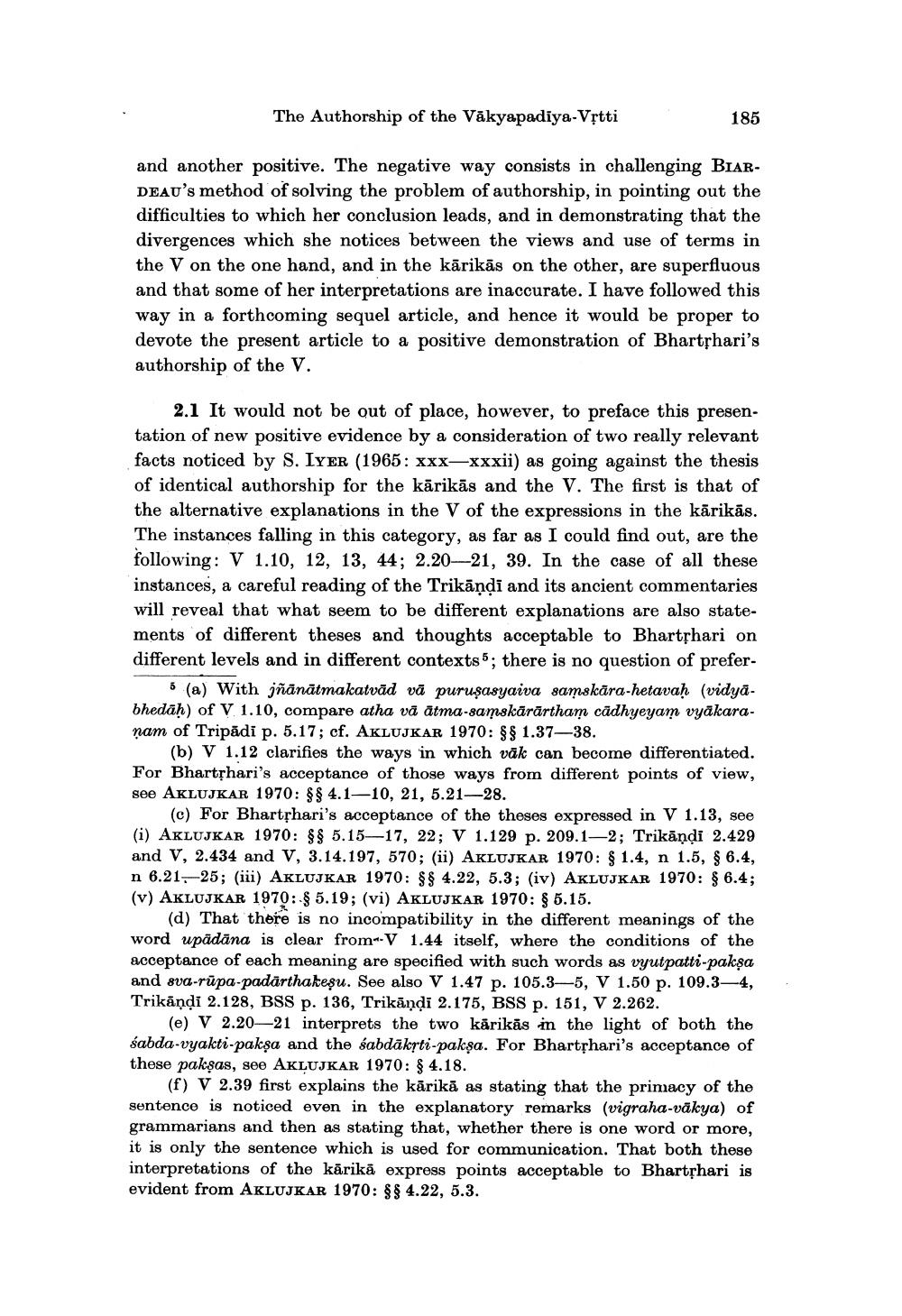Book Title: Authorship Of Vakyapadiya Vrtti Author(s): Ashok Aklujkar Publisher: Ashok Aklujkar View full book textPage 5
________________ The Authorship of the Vākyapadiya-Vrtti 185 and another positive. The negative way consists in challenging BIARDEAU's method of solving the problem of authorship, in pointing out the difficulties to which her conclusion leads, and in demonstrating that the divergences which she notices between the views and use of terms in the V on the one hand, and in the kārikās on the other, are superfluous and that some of her interpretations are inaccurate. I have followed this way in a forthcoming sequel article, and hence it would be proper to devote the present article to a positive demonstration of Bhartphari's authorship of the V. 2.1 It would not be out of place, however, to preface this presentation of new positive evidence by a consideration of two really relevant facts noticed by S. IYER (1965: xxx-xxxii) as going against the thesis of identical authorship for the kārikās and the V. The first is that of the alternative explanations in the V of the expressions in the kārikās. The instances falling in this category, as far as I could find out, are the following: V 1.10, 12, 13, 44; 2.20—21, 39. In the case of all these instances, a careful reading of the Trikāņdi and its ancient commentaries will reveal that what seem to be different explanations are also statements of different theses and thoughts acceptable to Bhartshari on different levels and in different contexts 5; there is no question of prefer 5 (a) With jñānātmakatvād vă puruşasyaiva samskāra-hetavah (vidyābhedāh) of V 1.10, compare atha vā ātma-samskārārtham cădhyeyam vyākaranam of Tripādi p. 5.17; cf. AKLUJKAR 1970: $ $ 1.37–38. (b) V 1.12 clarifies the ways in which vāk can become differentiated. For Bhartshari's acceptance of those ways from different points of view, see AKLUJKAR 1970: $$ 4.1–10, 21, 5.21-28. (c) For Bhartphari's acceptance of the theses expressed in V 1.13, see (i) AKLUJKAR 1970: $ $ 5.15-17, 22; V 1.129 p. 209.1–2; Trikāņdi 2.429 and V, 2.434 and V, 3.14.197, 570; (ii) AKLUJKAR 1970: $ 1.4, n 1.5, $ 6.4, n 6.21-25; (iii) AKLUJKAR 1970: $$ 4.22, 5.3; (iv) AKLUJKAR 1970: $ 6.4; (v) AKLUJKAR 1970: $ 5.19; (vi) AKLUJKAR 1970: $ 5.15. (d) That there is no incompatibility in the different meanings of the word upādāna is clear from--V 1.44 itself, where the conditions of the acceptance of each meaning are specified with such words as vyutpatti-paksa and sva-rūpa-padārthakesu. See also V 1.47 p. 105.3—5, V 1.50 p. 109.3–4, Trikāņdi 2.128, BSS p. 136, Trikāndi 2.175, BSS p. 151, V 2.262. (e) V 2.20—21 interprets the two kārikās in the light of both the sabda-vyakti-pakşa and the sabdākrti-pakşa. For Bhartshari's acceptance of these paksas, see AKLUJKAR 1970: $ 4.18. (f) V 2.39 first explains the kārikā as stating that the primacy of the sentence is noticed even in the explanatory remarks (vigraha-väkya) of grammarians and then as stating that, whether there is one word or more, it is only the sentence which is used for communication. That both these interpretations of the kārikā express points acceptable to BhartȚhari is evident from AKLUJKAR 1970: 88 4.22, 5.3. 1970.ceptance ofrys in which : $$ 1.37Page Navigation
1 ... 3 4 5 6 7 8 9 10 11 12 13 14 15 16 17 18
